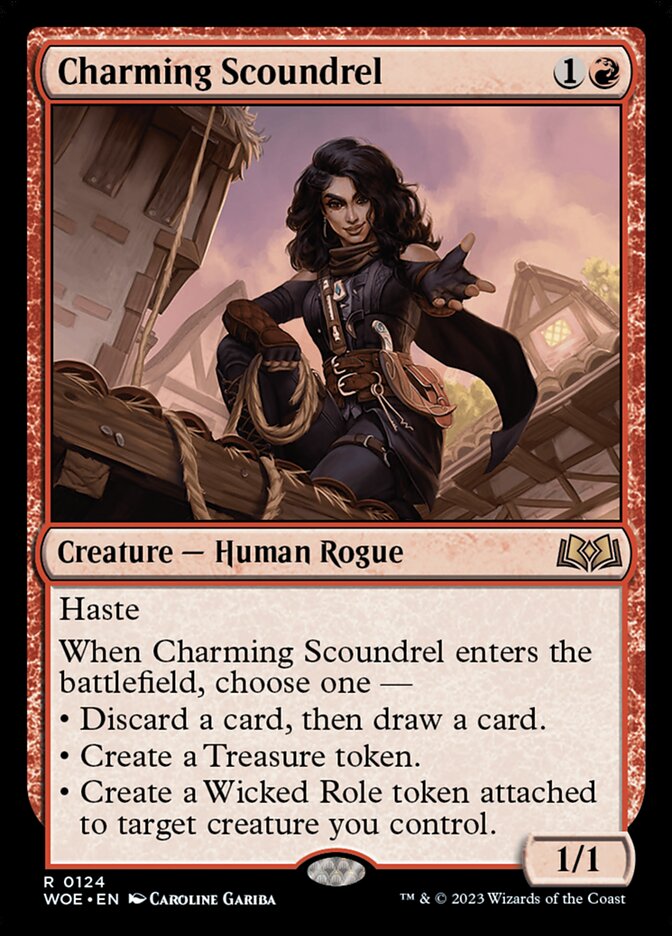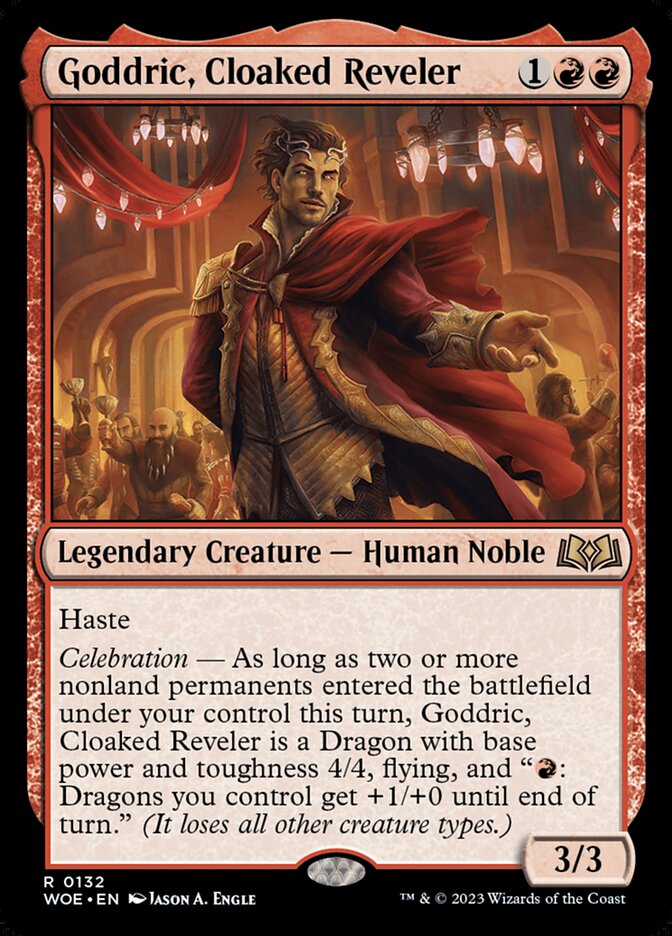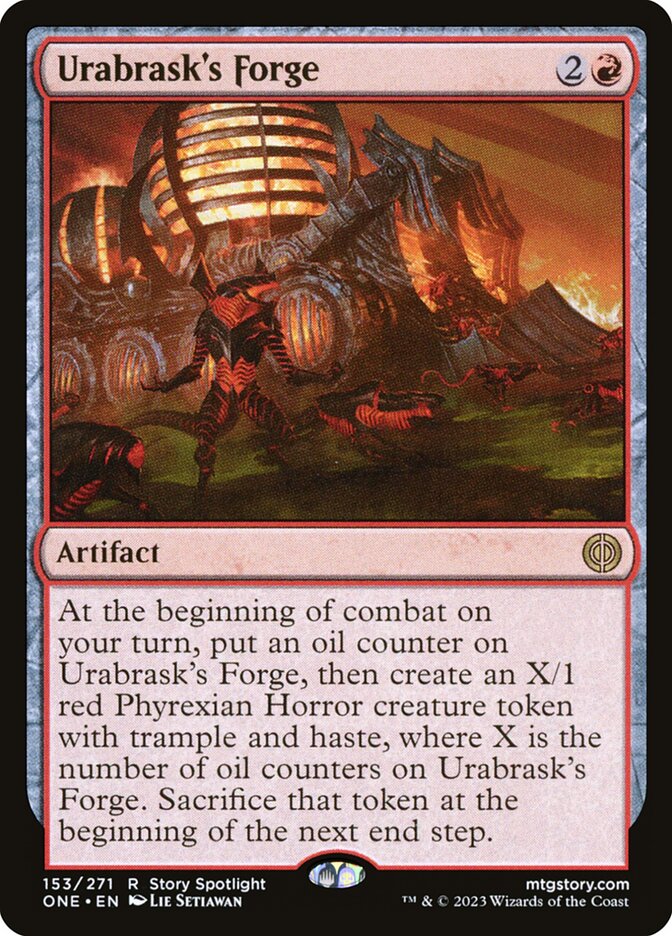Standard Mono-red Aggro Deck & Sideboard Guide
Quick intro
Monored is a deck that, from time to time, yields significant results in various tournaments, even being the chosen deck of a few professionals in the Worlds Championship. Having gained a few cards from Wilds of Eldraine, it seems to have firmly established its place among the tiers of the format in Standard. Today, I'll delve into this new list, discussing some card choices, keep/mull decisions, and provide a side guide against the main match-ups.
My current version of the deck

| Creature [27] | ||
|---|---|---|
| 4 Bloodthirsty Adversary | $1.99 | |
| 4 Kumano Faces Kakkazan | $0.59 | |
| 3 Phoenix Chick | $0.79 | |
| 1 Shivan Devastator | $5.49 | |
| 3 Squee, Dubious Monarch | $1.29 | |
| 1 Feldon, Ronom Excavator | $0.49 | |
| 4 Monastery Swiftspear | $0.69 | |
| 4 Charming Scoundrel | $2.79 | |
| 3 Goddric, Cloaked Reveler | $0.49 | |
| Instant [9] | ||
|---|---|---|
| 4 Play with Fire | $4.49 | |
| 4 Lightning Strike | $0.35 | |
| 1 Witchstalker Frenzy | $0.69 | |
| Sorcery [1] | ||
|---|---|---|
| 1 Nahiri's Warcrafting | $0.49 | |
| Land [23] | ||
|---|---|---|
| 18 Mountain | $0.01 | |
| 2 Sokenzan, Crucible of Defiance | $6.49 | |
| 3 Mishra's Foundry | $1.79 | |
| Sideboard [15] | ||
|---|---|---|
| 1 End the Festivities | $1.99 | |
| 2 Thundering Raiju | $0.79 | |
| 1 Jaya, Fiery Negotiator | $0.99 | |
| 1 Brotherhood's End | $7.99 | |
| 1 Koth, Fire of Resistance | $0.79 | |
| 3 Urabrask's Forge | $4.99 | |
| 3 Lithomantic Barrage | $0.99 | |
| 1 Nahiri's Warcrafting | $0.49 | |
| 1 Torch the Tower | $0.35 | |
| 1 Witchstalker Frenzy | $0.69 | |
 $22.63 Tix @cardhoarder
$22.63 Tix @cardhoarder
 $0.99 / Week @cardhoarder
$0.99 / Week @cardhoarder
 $67.85 @tcgplayer
$67.85 @tcgplayer
 $109.81 @cardkingdom
$109.81 @cardkingdom
The list has undergone several alterations since my last piece, largely due to the evolving nature of the format itself, which has welcomed new decks and has significantly changed. It is now characterized by decks that play a somewhat unfair game, utilizing high-cost spells. The speed of the Mono-red deck severely punishes these strategies.
Card choices
Charming Scoundrel
One of the cards that really caught me off guard. In this list is a highly versatile two-drop. It can ramp to ensure a three-drop or even a sideboard four-drop on the next turn, mitigate land flooding by offering cycling, and still poses a significant threat. This is especially true if played after a Kumano, or by placing a wicked hole token on another creature, thereby escalating its threat level on the board. It's a level of versatility that Mono-red has seldom seen in recent times, so crucial that it has even replaced the previously irreplaceable card, Feldon. Even though Feldon is legendary, it was played in more copies.
Goddric, Cloaked Reveler
Another card that truly astounded me. On its own, it's a decent creature with a 3/3, but what's striking is how effortlessly it can morph into a 4/4 flyer with an in-built "fireball". Kumano is the most obvious synergy, dropping it on turn 1, then on turn 3 it enters the battlefield and assists as a second permanent entering the game, if you manage to summon Goddric in the same turn. Moreover, it synergizes with other cards, like Charming Scoundrel, Squee and the tokens from Sokenzan (it even reduces the channel cost). This is one of the cards that certainly elevated the deck's level, providing evasion for a deck that sometimes struggles to deal damage in stalled tables, and it does this remarkably well.
Urabrask’s Forge
A card that isn't necessarily brand new, but has been impressing me as much as the fresh additions. Mono-red really struggles against decks that are heavy on removals, particularly post-sideboard, and that's where the forge really shines. Against midrange decks with black, for instance, you can shift your game plan and play as a midrange too, with removals and threats like planeswalkers and the forge itself. It's also very effective against control, becoming an exponentially increasing threat as you continue to put more threats on the board, making your opponent's life increasingly difficult.
Playing the deck
The deck strategy is pretty straightforward. Starting off with Kumano greatly enhances your opening hand, as we know that the first creature will likely evade Cut Down, one of the main removals in the format. Curve out from the early turns, making way for your three drops to shine at the right time, with burns to finish the game and remove blockers from the path. It's a classic monored game play.
Example Hand #1

It's not the perfect hand, but it's definitely playable. We have an excess of removals, and if one of these Strikes was a 1-drop, it would make for a much better hand. Nevertheless, we can secure a turn 3 Squee, which depending on the deck, can put significant pressure on the opponent. It's a fairly playable hand, and I'm not a fan of mulliganing minimally playable hands, so it's a keep.
Example Hand #2

Extremely reactive hand, doesn't apply pressure and has a surplus of lands (although two of them are also creatures). I'd recommend a mulligan.
Example Hand #3

As a post-sideboard hand, with cards more geared toward midrange, even though it's not exactly curving out, I believe it's a keep. You've got solid removal, turn-2 creatures (if you want to apply pressure), and a planeswalker that really shines in the right matchups. It's a keep. One thing to note about this deck is that you have the flexibility to shift the game plan to play a more midrange style if necessary, and you also have the ability to curve out and apply a lot of pressure. It's just a matter of knowing the best strategy and executing it.
Matchups & Sideboard guide
Esper Legends
The deck has made a resurgence, and while that's not great for us, I'm quite fond of the post-sideboard strategy. The setups vary - some run Thalia, others include Wedding Announcement in the main deck, so our plan must adjust accordingly. In Game 1, we don't have a lot of removal for Raffine and Sheoldred, but even a Dennick with counters can be a pain. Save your removal for these key creatures and try to apply pressure on the board. Post-sideboard, the game plan changes as they have even more removal, so we shift to a midrange strategy. We need to know when to use our removal correctly (for instance, using Strike on Dennick and Barrage on Raffine). This may appear straightforward, but it's worth keeping in mind when playing with this deck.
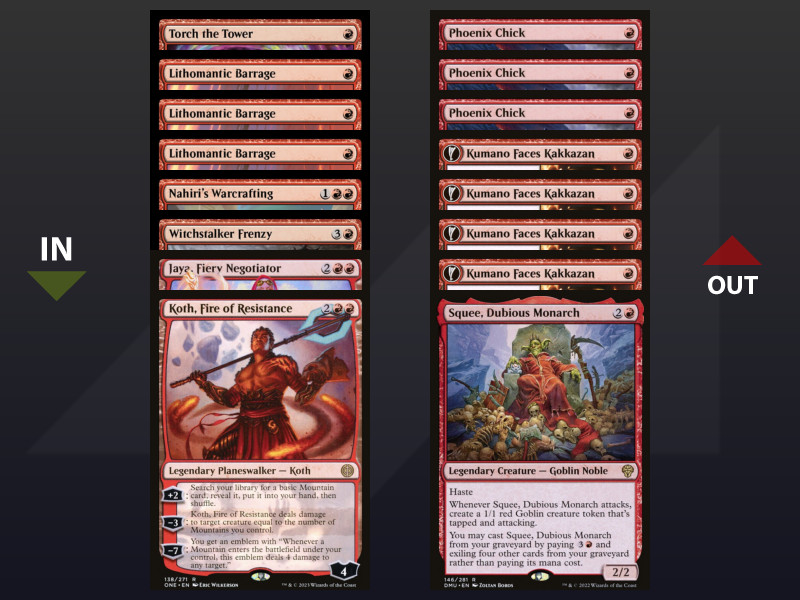
Monored Aggro
A mirror match, as is often the case, provides a significant advantage to the player who goes first. If you're playing with Kumano, it can be incredibly tough for the opponent to hold their own, especially since the first creature will likely evade Play with Fire. Not to mention, the player who goes first already has a head start in terms of damage (thanks to Kumano). This match tends to be a damage race, at least in the first game. The key is knowing when to play more defensively and the right time to shift the race in your favor. Post-sideboard, I must admit, I'm still unsure about the optimal strategy. However, I believe as the number of removals increase, more resilient cards like planeswalkers become preferable. Perhaps a midrange strategy is best, with Jaya acting as the red equivalent of Wedding Announcement and Koth coming in to remove a Godric or even a Thundering Raiju.
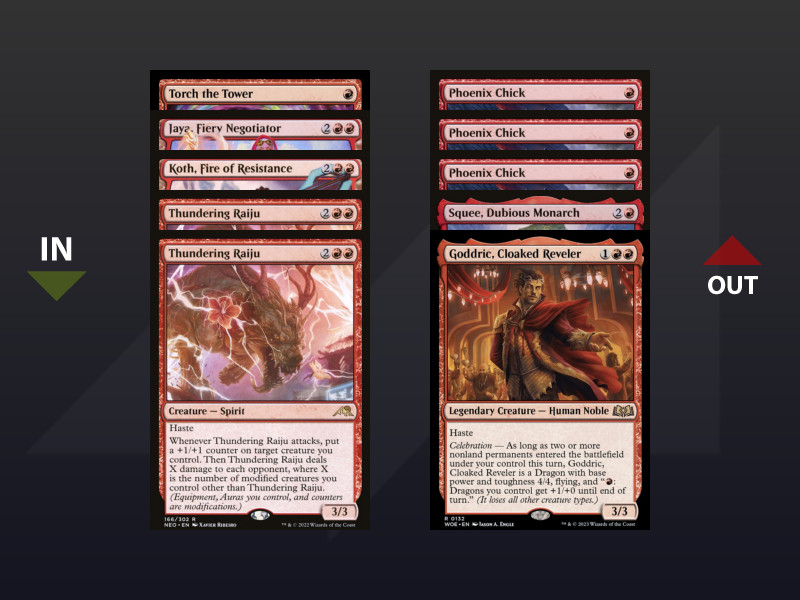
UW Soldiers
The game used to be a lot better, but I still believe it's favorable. The latest Soldier decks are now incorporating Lunarch Veteran and Wedding Announcement, as well as Werefox Bodyguard, which has essentially turned the deck into an almost UW Tokens with significantly more life gain than previous versions. So, game one has deteriorated, but I believe game two will be better, with more sweepers, also playing a more midrange game.
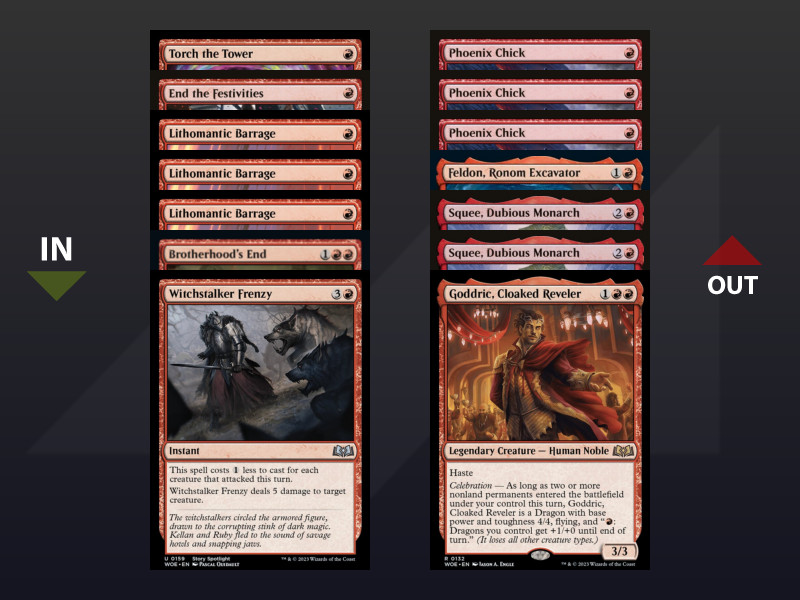
Domain Ramp
Pressure, curved hands, and finishing with burns. The deck is slow, so we need to take advantage of that, even though some removals like Virtue of Persistence can pose significant challenges. Post-sideboard, we don't have a very effective plan. We don't want to play a midrange game because it loses miserably to Atraxa, Grand Unifier. We need more targeted removals and Thundering Raiju to supplement the damage.

BG Midrange
Another matchup, quite similar to Esper Legends. There are key creatures that need to be removed as they block our attacks and generate significant value on their own. With a high volume of removals, we need to shift towards a midrange strategy. The good news here is the absence of Wedding Announcement, so our spot removals become much more effective. Combined with the Forge plan with planeswalkers, this matchup becomes much more winnable post-sideboard than in game one.

Esper Control
The deck essentially boils down to numerous removals, counters, and The Wandering Emperor. Unfortunately, these combinations aren't particularly advantageous for this deck. It launches assaults from numerous angles and has solutions for practically everything, making the first game quite challenging. All we can do is aim to defeat it as swiftly as possible, avoiding Cut Down whenever possible and making threats at the appropriate times. After sideboarding, Urabrask’s Forge shines a lot; they essentially have Void Rend to respond effectively. However, they don't have several copies, so we can capitalize on this. We'll need some specific removals post-sideboarding as it's likely to have Sheoldred and Chrome Host Seedshark, so we should also increase the five-damage removals.
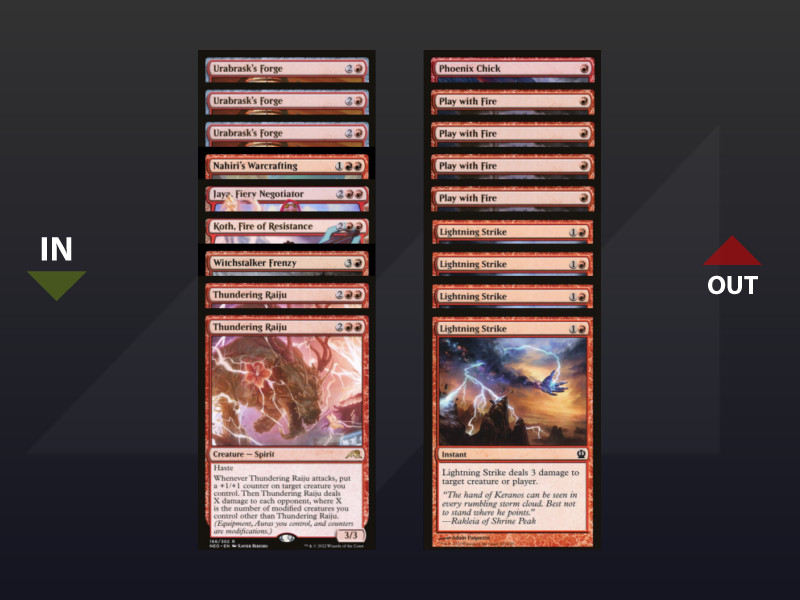
Final words
Mono-red is a deck that, from time to time, makes a surprising appearance in a tournament. It was even chosen by some players in the last World Championship, despite not performing overly well in that tournament. Capable of being highly aggressive or playing a more midrange strategy, it's one of my preferred choices for playing in major tournaments, especially when opponents aren't particularly focused on it.
Until next time!


